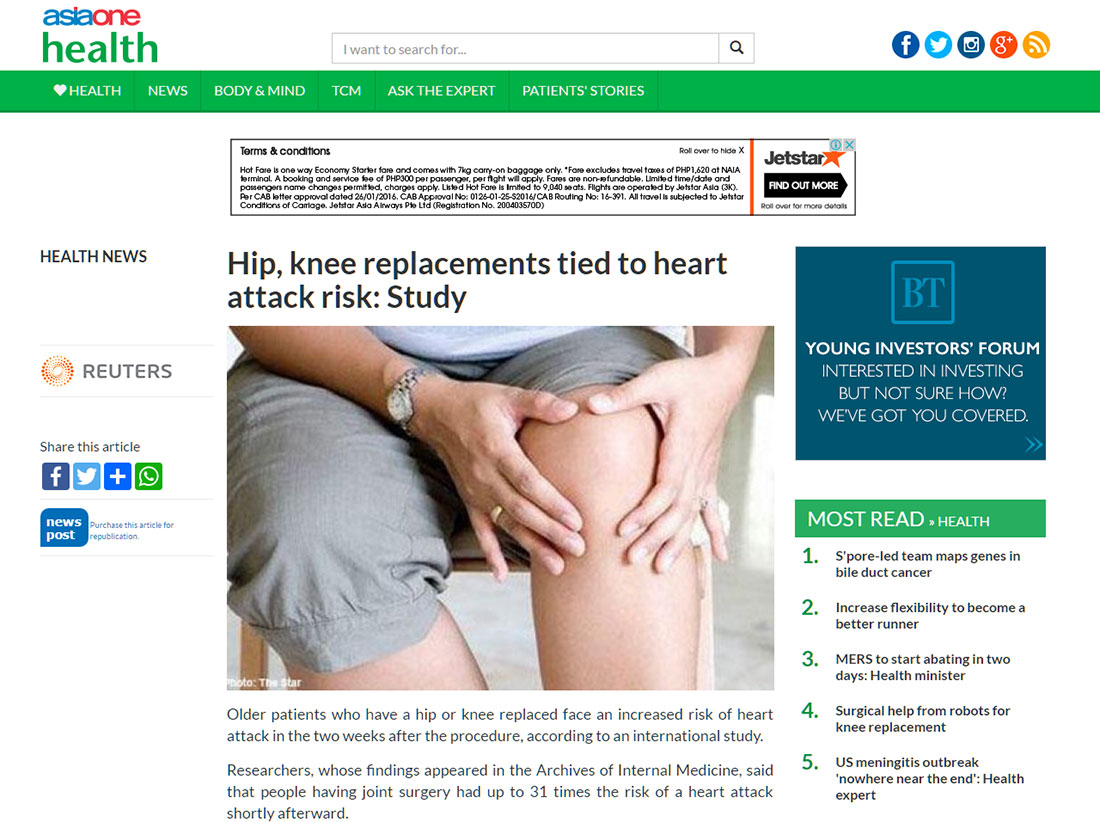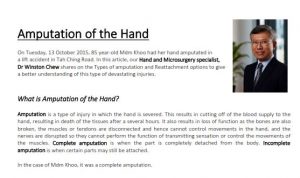This article reports a well-known fact which doctors call perioperative risks. Remember that we are talking about the elderly who undergo a major elective operation which is a replacement of a major part of the anatomy. This involves the implantation of a large foreign metallic material, often with the inclusion of liquid cement to weld the metal to the bone. Let me explain the technicalities.
The metal is made usually of an alloy-mix which has cobalt, chrome, titanium, zinc and nickel. There is a 2-3% incidence of metal allergy to one or more components of this alloy. Fortunately, it is rare and may occur sometime after implantation and of a mild severity. In rare cases, the patient may develop a hypersensitivity reaction which may mimic a heart attack.
The liquid cement is often used in the osteoporotic bone to fill the gap between metal and porous bone in order to reduce the risk of loosening over the years. This cement is a combination of volatile material (polymethyl methacrylate) by mixing a powder with a liquid. Think of a two-part epoxy glue. In fact, the odour during mixing is similar. The main difference is that cyanoacrylate is poisonous and not used in body cement. During injection of the liquid cement into the bony canal, small molecules may enter the bloodstream and cause the heart to slow down (bradycardia) which may result in loss of pumping power thus resulting in a heart attack. This is a well-known but rare risk and the surgeon usually waits for the cement to polymerise so that small molecules are minimised. The anaesthetist is also warned of the impending injection so he can monitor the patient more closely and prevent this fall in blood pressure. This may happen in 1-in-20 to 1-in-40 patients and is part of the pre-op counselling given by the surgeon and anaesthetist.
Acute myocardial infarcts (AMI, or heart attacks) are an expected risk especially for elderly with heart disease. For the patient, this risk must be outweighed by the benefits of a pain-free mobile knee joint before agreeing to surgery. It is a curious fact that heart disease patients who need to undergo treadmill stress test cannot do so because of the knee or hip arthritis and heart patients who need exercise rehabilitation also cannot complete the regimes for the same reason. Joint replacement actually improves their function so they can recover from heart disease.
Another relevant factor is deep vein thrombosis (DVT, or clots in the leg blood vessels) and pulmonary embolism (PE, or loose clots plugging up critical lung vessels). DVT may occur in 15-20% of patients undergoing hip and knee replacements but only 1% develops into PE, which mimics a heart attack. Standard precautions include the use of special long stockings, pneumatic foot pumps, anti-clotting drugs and routine vein ultrasound scans before each patient is discharged. Early physiotherapy and walking within 1-2 days also reduces the clot-forming rates, so lying immobile in bed after surgery is not a good thing, both for veins and the heart.
Finally, the study was conducted from 1999-2007 and is thus more than 10 years old. Although it involved a large number of patients, this reflects a state-of-the-art a decade ago. AMI risks have been significantly lowered nowadays by earlier diagnosis, better-managed disease and evolution of regional anaesthesia. Regional anaesthesia and moderate sedation are far safer than general anaesthesia in most cases where hip and knee replacement. This comes in the form of spinal and nerve blocks which leaves the heart and lungs free of powerful inhaled drugs. These blocks can be made to last into the second and third post-op days by leaving a catheter in place for drug infusion, thereby providing complete pain relief in the conscious patient. They can start talking and eating when they “wake up” from surgery. Stress, being a significant factor in the causation of heart attacks, is effectively reduced for someone who expects much pain after such a major operation.
In summary, the decision for elective surgery must always weigh the factors of pre-existing disease state, need for the surgery, and the type of anaesthesia administered. The patient and family should ask the surgeon about the risks and precautions as stated above and satisfy themselves that all will be done that can be done to make hip and knee replacements a lower-risk operation which clearly improves the quality of life for the older folks who can and wish to remain mobile and independent in their silver years.
Written by Dr. Khong Kok-Sun.






